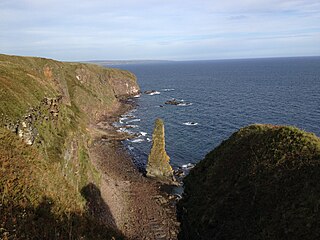
Caithness is a historic county, registration county and lieutenancy area of Scotland.

Golspie is a village and parish in Sutherland, Highland, Scotland, which lies on the North Sea coast in the shadow of Ben Bhraggie. It has a population of around 1,350.

Clan Sinclair is a Highland Scottish clan which holds the lands of Caithness, the Orkney Islands, and the Lothians. The chiefs of the clan were the Barons of Roslin and later the Earls of Orkney and Earls of Caithness.
The Sutherland and Caithness Railway was a Scottish railway company that built a line from Helmsdale, the terminus of the Duke of Sutherland's Railway to Wick and Thurso in Caithness, giving the northern towns access to Inverness. It was driven through by the efforts of the 3rd Duke of Sutherland and the engineer Joseph Mitchell in the face of apathy from interests in Wick.
The KW postcode area, or Kirkwall postcode area, is a group of sixteen postcode districts in the far north of Scotland, within fifteen post towns. These cover Caithness, east Sutherland and the Orkney Islands.

The John o' Groats Trail is a Scottish long-distance walking route from Inverness to John o' Groats, traversing back lanes, footpaths, shorelines and cliff tops of the Scottish Highlands. The trail gives access to accommodation, meals and shops at the end of each stage of the walk.

The 1st Orkney Artillery Volunteers (OAV) was a part-time unit of Britain's Royal Artillery formed in the Orkney Islands in 1860 as a response to a French invasion threat. The unit served as coast artillery until it was disbanded after World War I.
The 1st Kent Artillery Volunteers was a part-time unit of the British Army's Royal Artillery from 1860 to 1956. Primarily serving as coastal artillery defending the Port of Dover and other harbours in South-East England, the unit's successors also served in the heavy artillery role on the Western Front during World War I and as anti-aircraft artillery during the Blitz and later in the North African and Italian campaigns of World War II.
The 1st North Riding Artillery Volunteers was a part-time unit formed in the North Riding of Yorkshire in 1860 in response to an invasion scare. The unit later became part of the Territorial Force and served on the Western Front during World War I, while their successors served as anti-aircraft gunners in World War II.
The Berwickshire Artillery Volunteers were formed in 1860 as part of the Volunteer Force, as a result of a French invasion threat. They served as a Coastal Artillery unit and continued in existence until being disbanded on the formation of the Territorial Force in 1908.
The Cheshire Artillery Volunteers was a brigade of Volunteer artillery units raised in the county of Cheshire in the mid-19th century. Their successors served as field artillery in Palestine during World War I and as anti-aircraft (AA) gunners in the Middle East in World War II. They continued in the air defence role in the Territorial Army until 1955.
The 1st Aberdeenshire Artillery Volunteers was a part-time unit of the British Army raised in Aberdeenshire and neighbouring counties in Scotland in 1860. Its successor units served with 51st (Highland) Division through many of the major battles on the Western Front during the First World War. In the Second World War one of its regiments escaped the surrender of the 51st (Highland) Division in 1940 and went on to serve as heavy artillery in the Italian Campaign. The other regiment served with the reconstituted division at Alamein, in Sicily, Normandy and through North West Europe to the Rhine Crossing and beyond. It served on in the Territorial Army until 1967.
The 1st Banffshire Artillery Volunteers was a part-time unit of the British Army's Royal Artillery founded in Banffshire in Scotland in 1859. Through various reorganisations it served as auxiliary garrison artillery until 1908.
The 1st Renfrew and Dumbarton Artillery Volunteers was a part-time unit of the British Army's Royal Artillery founded in Scotland in 1860. During the First World War, it served with 51st (Highland) Division at the Battle of the Somme before being broken up. In the Second World War, the regiment saw action in the Battle of France, in the campaigns in North Africa, Sicily, Italy, the Greek Civil War and in North West Europe. It continued in the postwar Territorial Army until 1969.
The 1st Inverness-shire Artillery Volunteers, later the Highland Artillery Volunteers, was a Scottish auxiliary unit of the British Army from 1860 to 1908. With its headquarters in Inverness, it was recruited for home defence from a number of shires in the northern Scottish Highlands. It later provided the basis for a number of Territorial Force units in the Highlands.

The Cinque Ports Division, Royal Artillery was an administrative grouping of garrison units of the Royal Artillery, Artillery Militia and Artillery Volunteers within the British Army's South Eastern District from 1882 to 1889.

The Scottish Division, Royal Artillery, was an administrative grouping of garrison units of the Royal Artillery, Artillery Militia and Artillery Volunteers within the British Army's Scottish District from 1882 to 1889.

The Southern Division, Royal Artillery, was an administrative grouping of garrison units of the Royal Artillery, Artillery Militia and Artillery Volunteers within the British Army's Southern District from 1882 to 1902.
The Cumberland Artillery was a group of Volunteer artillery batteries formed in the county of Cumberland, England, in 1860. They became part of the Royal Garrison Artillery, and when the Territorial Force was created in 1908 they formed a Royal Field Artillery howitzer brigade for the East Lancashire Division. In World War I the brigade served at Gallipoli and in Egypt, then was broken up amongst the divisional artillery: its batteries fought on the Western Front for the rest of the war. In the 1920s the Cumberland Artillery batteries combined with the Westmorland and Cumberland Yeomanry to form a new field regiment of the Royal Artillery that saw considerable action in World War II.







